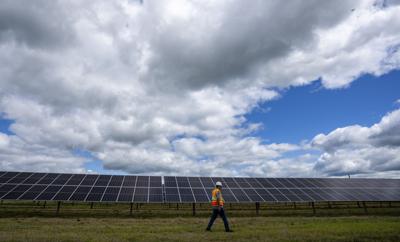ItŌĆÖs easy for North Americans, inundated by Trump news, to start to assume that the entire world has lost interest in decarbonization. Nothing could be further from the truth.
There are, in fact, too many examples to cite to illustrate the opposite. Here are just a few that show cutting emissions is now fully aligned with basic economics.
India, the worldŌĆÖs third largest emitter, is introducing a next year. The country already hit its target of having coming from nonfossil fuels .╠²
The European Union, one of CanadaŌĆÖs most important trading partners, is in the process of setting an emissions target of . The trading bloc is to meet its 2030 target of 55 per cent reduction. In 2023 alone, the EU slashed its collective emissions by eight per cent.╠²
ThatŌĆÖs remarkable progress enabled by soaring renewable installations. In June, for example, solar power produced on the continent.
But most significantly, ChinaŌĆÖs commitment to electrification means the die is cast and the world is rapidly . In fact, China and the EU recently to step up efforts to address climate change.
Much has been said about the stunning rise of renewables in China. It has helped put and in the first quarter of this year, despite growth in electricity demand.
China is ŌĆö which is already the largest of its kind in the world ŌĆö to include steel, cement and aluminum. And the country is electrifying transport at a dizzying pace. Last year, roughly sold in China ŌĆö by far the worldŌĆÖs largest automarket ŌĆö came with a plug-in.
That has helped move numbers internationally. Globally, electric vehicles are set to make up more than sold this year, according to the International Energy Agency.
All of this has knock-on effects for Canada.
Six months ago, the U.S. was all-in on electrification. It will be again. The economics of the energy transition will increasingly become too obvious to ignore. ThatŌĆÖs already the case in states like Texas where and Enbridge is putting into a massive solar project ŌĆö a ŌĆ£man bites dogŌĆØ storyline for the climate era.╠²
In the meantime, Canada has an opportunity to become a global player by building on one of our greatest natural advantages: dispatchable clean power.
The challenge is that we donŌĆÖt have one national energy grid, we have many disconnected ones. ThatŌĆÖs a big obstacle because the name of the game in the energy transition is to ŌĆ£electrify nearly everything.ŌĆØ┬Ā
And while 80 per cent of CanadaŌĆÖs electricity is currently emissions-free, we are going to need to build more clean power at a rapid clip to attract investments that decarbonize industry, buildings and transportation, while supporting growth in artificial intelligence.
The good news is that expanding clean power supply and connecting it across provinces fits with the current ŌĆ£one Canadian economyŌĆØ zeitgeist. It on Prime Minister Mark CarneyŌĆÖs list ŌĆö it supports economic autonomy, breaks down internal trade barriers, accelerates clean growth and decarbonization, and advances opportunities for Indigenous communities.
In short, building electricity systems should be the top priority of the federal governmentŌĆÖs promise to build projects that are in the national interest.
The goal is eminently doable. We have the know-how, the resources and the political commitment to make it happen. We just need to get to work.
The alternative is to misread our current moment and stay the course. Clinging to past economic models in times of great change does not preserve competitive advantage. It cedes it. ThatŌĆÖs a grave danger for Canada in a world that is rapidly building a future where clean energy and economic growth are mutually reinforcing.
Error! Sorry, there was an error processing your request.
There was a problem with the recaptcha. Please try again.
You may unsubscribe at any time. By signing up, you agree to our and . This site is protected by reCAPTCHA and the Google and apply.
Want more of the latest from us? Sign up for more at our newsletter page.
























To join the conversation set a first and last name in your user profile.
Sign in or register for free to join the Conversation